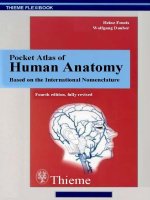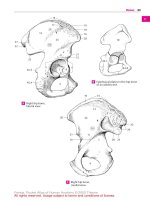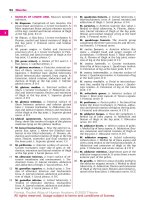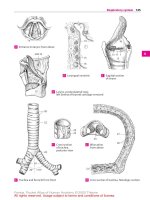BD Chaurasia''s Handbook of General Anatomy, 4th Edition[Ussama Maqbool]
Bạn đang xem bản rút gọn của tài liệu. Xem và tải ngay bản đầy đủ của tài liệu tại đây (20.53 MB, 276 trang )
B D Chaurasia'S
Late Dr B D Chaurasia
1937-1985
B D Chaurasia'S
Fourth Edition
Late Dr B D Chaurasia
MBBS, MS, PhD, FAMS
Department of Anatomy
G.R. Medical College
Gwalior, India
Edited by
Dr. Krishna Garg
MBBS, MS, PhD, FIMSA, FIAMS, FAMS & Chikitsa Ratan
Ex. Prof. & Head, Deptt. of Anatomy,
Lady Hardinge Medical College, New Delhi
CBS
CBS PUBLISHERS & DISTRIBUTORS PVT. LTD.
NEW DELHI • B E N G A L U R U • PUNE • KOCHI • CHENNAI
WWW.CBSPD.COM
BD Chaurasia's
Handbook of
GENERAL ANATOMY
Fourth Edition
ISBN: 978-81-239-1654-5
Copyright © Author and Publisher
Fourth Edition: 2009
Reprint: 2010, 2011,2012, 2013
First Edition: 1978
Second Edition: 1983
Third Edition: 1996
All rights reserved. No part of this book may be reproduced or transmitted in dny form
or by any means, electronic or mechanical, including photocopying, recording, or
any information storage a n d retrieval system without permission, in writing, from the
author a n d the publisher.
Published by Satish Kumar Jain for
CBS Publishers & Distributors Pvt Ltd
4819/XI Prahlad Street, 24 Ansari Road, Daryaganj, New Delhi 110002, India.
Ph: 23289259, 23266861, 23266867
Website: www.cbspd.com
Fax: 011 -23243014
e-mail: :
Corporate Office: 204 FIE, Industrial Area, Patparganj, Delhi 110092
Ph: 4934 4934
Fax: 4934 4935
e-mail: ;
Branches
• Bengaluru: Seema House 2975, 17th Cross, K.R. Road,
Banasankari 2nd Stage, Bengaluru 560 070, Karnataka
Ph:+91-80-26771678/79
Fax:+91-80-26771680
e-mail: bangalorefflcbspd.com
• Chennal: 20, West Park Road, Shenoy Nagar, Chennai 600 030, Tamil Nadu
Ph: +91-44-26260666,26208620
Fax: +91-44-42032115
e-mail:
• Kochi: 36/14 Kalluvilakam, Lissie Hospital Road, Kochi 682 018, Kerala
Ph:+91-484-4059061-65
Fax:+91-464-4059065
e-mail:
• Mumbal: 83-C, Dr E Moses Road, Worli, Mumbai-400018, Maharashtra
Ph:+91-9833017933
e-mail:
• Pune: Bhuruk Prestige, Sr. No. 52/12/2+1 +3/2 Narhe, Haveli
(Near Katraj-Dehu Road Bypass), Pune 411 041, Maharashtra
Ph:+91-20-64704058,64704059, 32342277 Fax:+91-20-24300160
e-mall: pune@cbsr d . c o m
Representatives
•
Hyderabad
• Nagpur
0-9885175004
•
0-9021734563
• Patna
Kolkata
Printed at SDR Printers, Delhi-94 (India)
0-9831437309,0-9051152362
0-9334159340
Preface to the Fourth Edition
I feel a sense of pride and enthusiasm in presenting to you the fourth
edition of this popular book. Now, simple coloured diagrams
extensively illustrate each chapter. Once initial interest to read text
supplemented by diagrams is developed, learning general anatomy is
hardly problematic.
Clinical anatomy has been illustrated with coloured diagrams.
Students have always been encouraging me in improving both text
and diagrams.
The help of Ms. Priya, MBBS student of Lady Hardinge Medical
College during 1990-91, is being acknowledged for improving the
"Anatomical word meanings and historical names."
Mr. Ajit Kumar, first year student of Banarasidas Chandiwala
Institute of Physiotherapy (BCIP) 2004-05, gave constructive
suggestions for its betterment. Ms. Stuti Malhotra, first year student of
BCIP (2007-08), provided me with a number of tables in various
chapters. I feel highly obliged to them.
The editor is obliged to Mr. Y.N. Arjuna, Publishing Director, CBS
for timely and much needed guidance. Page layout and four colour
diagrams work have been diligently done by Ms. Nishi Verma and
Mr. Chand Singh Naagar of M/s. Limited Colors.
Mr. Vinod Jain, Production Director, and Mr. Satish Jain, Chairman,
CBS Publishers and Distributors, have been helping me from time to
time. Comments from the students are welcome.
Krishna Garg
Editor
dedicated
to
my teacher
Shri Uma Shankar Nagayach
Preface to the First Edition
This handbook of general anatomy has been written to meet the
requirements of students who are newly admitted to medical colleges.
It thoroughly introduces the greater part of medical terminology, as
well as the various structures which constitute the human body. On
account of the late admissions and the shorter time now available for
teaching anatomy, the coverage of general anatomy seems to suffer
maximum. Since it lays down the foundation of the entire subject of
medicine, it was felt necessary to produce a short, simple and
comprehensive handbook on this neglected, though important, aspect
of the subject. It has been written in a simple language, with the text
classified in small parts to make it easier for the students to follow and
remember. It is hoped that this will prove quite useful to the medical
students.
Gwalior
November 1978
B D CHAURASIA
Contents
Preface to the Fourth Edition
v
Preface to the First Edition
vii
1. Introduction
1
2. Skeleton
29
3. Joints
57
4. Muscles
83
5. Cardiovascular System
101
6. Lymphatic System
123
7. Nervous System
137
8. Skin and Fasciae
171
9. Connective Tissue, Ligaments and Raphe
195
10. Principles of Radiography
Anatomical
Word Meanings and Historical Names
References and Suggestions for Additional
Index
205
Reading
213
243
253
Human anatomy is the science which deals with the structure of the
human body. The term, 'anatomy', is derived from a Greek word,
"anatome", meaning cutting up. The term 'dissection' is a Latin
equivalent of the Greek anatome. However, the two words, anatomy
and dissection, are not synonymous. Dissection is a mere technique,
whereas anatomy is a wide field of study.
Anatomy forms firm foundation of the whole art of medicine and
introduces the student to the greater part of medical terminology.
"Anatomy is to physiology as geography is to history, i.e. it describes
the theatre in which the action takes place."
SUBDIVISIONS OF ANATOMY
Initially, anatomy was studied mainly by dissection. But the scope of
modern anatomy has become very wide because it is now studied by
all possible techniques which can enlarge the boundaries of the
anatomical knowledge.
The main subdivisions of anatomy are:
1. Cadaveric anatomy is studied on dead embalmed (preserved)
bodies usually with the naked eye (macroscopic or gross anatomy).
This can be done by one of the two approaches: (a) In 'regional
anatomy' the body is studied in parts, like the upper limb, lower
limb, thorax, abdomen, head and neck, and brain; (b) in'systemic
anatomy'' the body is studied in systems, like the skeletal system
(osteology) (Fig. 1.1), muscular system (myology), articulatory
system (arthrology or syndesmology), vascular system (angiology),
nervous system (neurology), and respiratory, digestive, urogenital
and endocrine systems (splanchnology). The locomotor system
inr»1n/^oc A c t a n l n m ;
oftV»t-r\lr\rrw o n r l
m\/AlAm?
2 I Handbook of General Anatomy
Skull
Rib
Humerus
Vertebral column
Radius
Ulna
Hand
Femur
•Tibia
Fibula
.Foot
Fig. 1.1: Skeletal system
2. Living Anatomy is studied by inspection, palpation (Fig. 1.2),
percussion, auscultation, endoscopy (bronchoscopy, gastroscopy),
radiography, electromyography, etc.
Fig. 1.2: Contracted muscles for palpation
3. Embryology (developmental anatomy) is the study of the
prenatal developmental changes in an individual. The
developmental history is called 'ontogeny'. The evolutionary history
on the other hand, is called 'phylogeny'.
4. Histology (microscopic anatomy) is the study of structures
with the aid of a microscope.
5. Surface anatomy (topographic anatomy) is the study of deeper
parts of the body in relation to the skin surface. It is helpful in
clinical practice and surgical operations (Fig. 1.3).
F i g . 1 . 3 : Palpating the dorsalis pedis artery
6. Radiographic and imaging anatomy is the study of the bones
and deeper organs by plain and contrast radiography by ultrasound and computerised tomographic (CT) scans (Fig. 1.4).
4 I Handbook of General Anatomy
Clavicle
Lung
Heart
Fig. 1.4: X-ray of chest (plain radiograph)
7. Comparative anatomy is the study of anatomy of the other
animals to explain the changes in form, structure and function
(morphology) of different parts of the human body.
8. Physical anthropology deals with the external features and
measurements of different races and groups of people, and with
the study of the prehistoric remains.
Fig. 1.5: Physical anthropology
9. Applied anatomy (clinical anatomy) deals with application of
the anatomical knowledge to the medical and surgical practice
(Fig. 1.6).
10. Experimental anatomy is the study of the factors which influence
and determine the form, structure and function of different parts
of the body.
11. Genetics deals with the study of information present in the
chromosomes.
Introduction I 5
Axillary
- Radial
Ulnar-
Fig. 1.6: The relation of nerves to the humerus and likelihood of their
injury in case of fracture
HISTORY OF ANATOMY
1. Greek Period (B.C.)
Hippocrates of Cos (circa 400 B.C.), the 'Father of Medicine', is
regarded as one of the founders of anatomy. Parts of Hippocratic
collection are the earliest anatomical descriptions.
Herophilus of Chalcedon (circa 300 B.C.) is called the "father of
anatomy". He was a Greek physician, and was one of the first to dissect
the human body. He distinguished cerebrum from cerebellum, nerves
from tendons, arteries from veins, and the motor from sensory nerves.
He described and named the parts of eye, meninges, torcular Herophili,
fourth ventricle with calamus scriptorius, hyoid bone, duodenum, prostate
gland, etc. We owe to him the first description of the lacteals. Herophilus
was a very successful teacher, and wrote a book on anatomy, A special
treatise of the eyes, and a popular handbook for midwives.
6 I Handbook of General Anatomy
2. Roman Period (A.D.)
Galen of Pergamum, Asia Minor (circa 130-200 A.D.), the "prince of
physicians", practised medicine at Rome. He was the foremost'
practitioner of his days and the first experimental physiologist. He
wrote voluminously and theorized and dogmatized on many medical
subjects like anatomy, physiology, pathology, symptomatology and
treatment. He demonstrated and wrote on anatomy De anatomicisadministrationibus. His teachings were followed and considered as
the infallible authority on the subject for nearly 15 centuries.
3. Fourteenth Century
Mundinus or Mondino d'Luzzi (1276-1326), the 'restorer of
anatomy', was an Italian anatomist and professor of anatomy at Bologna.
He wrote a book Anathomia which was the standard anatomical text
for over a century. He taught anatomy by dissection for which his text
was used as a guide. He was the most renowned anatomist before
Vesalius.
4. Fifteenth Century
Leonardo da Vinci of Italy (1452-1519), the originator of
cross-sectional anatomy, was one of the greatest geniuses the world
has known. He was a master of arts and contributed substantially
in mathematics, science and engineering. He was the first to describe
the moderator band of the right ventricle. The most admirable of his
works are the drawings of the things he observed with perfection and
fidelity. His 60 notebooks containing 500 diagrams were published in
1898.
5. Sixteenth Century
Vesalius (1514-1564), the 'reformer of anatomy', was German in origin,
Belgian (Brussels) by birth, and found an Italian (Padua) university
favourable for his work. He was professor of anatomy at Padua. He is
regarded as the founder of modern anatomy because he taught that
anatomy could be learnt only through dissections. He opposed and
corrected the erroneous concepts of Galen and fought against his
authority, thus reviving anatomy after a deadlock of about 15 centuries.
His great anatomical treatise De Febricia Humani Corporis, written
Introduction I 7
in seven volumes, revolutionized the teaching of anatomy and remained
as authoritative text for two centuries.
Vesalius studied first at Louvain and then at Paris under Gunther
and Sylvius. Eustachius was the rival of Vesalius. The followers of
Vesalius included Servetus, Columbus, Fallopius, Varolio, Vidius, etc.;
all of them lived during 16th century.
6. Seventeenth Century
William Harvey (1578-1657) was an English physician who
discovered the circulation of blood, and published it as Anatomical
Exercise on the Motion of the Heart and Blood in Animals. He also
published a book on embryology.
The other events of this century included: (a) the first recorded
human dissection in 1638 in Massachusetts; (b) foundation of
microscopic anatomy by Malpighi; and (c) introduction of alcohol as a
preservative.
7. Eighteenth Century
William Hunter (1718-1783) was a London anatomist and obstetrician.
He introduced the present day embalming with the help of Harvey's
discovery, and founded with his younger brother (John Hunter) the
famous Hunterian museum.
8. Nineteenth Century
Dissection by medical students was made compulsory in Edinburgh
(1826) and Maryland (1833). Burke and Hare scandal of 16 murders
took place in Edinburgh in 1828. Warburton Anatomy Act (1932) was
passed in England under which the unclaimed bodies were made
available for dissection. The ' A c t ' was passed in America
(Massachusetts) in 1831. Formalin was used as a fixative in 1890s.
X-rays were discovered by Roentgen in 1895. Various endoscopes
were devised between 1819 and 1899. The anatomical societies were
founded in Germany (1886), Britain (1887) and America (1888).
The noted anatomists of this century include Ashley Cooper
(1768-1841; British surgeon), Cuvier (1769-1832; French naturalist),
Meckel (1724-1774; German anatomist), and Henry Gray (1827-1861;
the author of Gray's Anatomy).
8 I Handbook of General Anatomy
9. Twentieth Century
The electron microscope was invented in 20th century. It was applied
in clinical practice, which made startling changes in the study of normal
and diseased conditions. Various modifications of electron microscope,
transmission EM and SEM, etc. were devised. These helped in better
understanding of the body tissues.
Besides plain X-rays, in this century, ultrasonography and
echocardiography were discovered. This was the non-invasive
safe-procedure.
Also computer-axial tomography or CT scan, a non-invasive
procedure and magnetic resonance imaging were devised. These were
extremely useful, sensitive means of understanding the dynamics of
body structure in health and disease.
Tissue culture was developed which was new and exciting field of
research.
New advances in cases of infertility were discovered, which gave
hopes to some infertile couples. GIFT: Gamete Intrafallopian Transfer
got started
10. Twenty First Century
Foetal medicine is emerging as a newer subject. Even treatment
'in-utero' is being practised in some cases.
Human genome is being prepared.
New research in drugs for many diseases, especially AIDS, is being
done very enthusiastically. There is also a strong possibility of gene
therapy.
Indian Anatomists
Dr. Inderjit Dewan worked chiefly on osteology and anthropology.
Dr. D.S. Choudhry did notable work on carotid body.
Dr. H. Chaterjee and Dr. H. Verma researched on embryology.
Dr. S.S. Dayal did good work in cancer biology.
Dr. Shamer Singh and his team did pioneering work on teratology.
Dr. Chaturvedi and Dr. C.D. Gupta's prominent work was on
corrosion cast.
Introduction I 9
Dr. L.V. Chako, Dr. H.N. Keswani, Dr. Veena Bijlani, Dr. Gopinath,
Dr. Shashi Wadhwa of All India Institute of Medical Sciences,
New Delhi, researched on neuroanatomy.
Dr. Keswani and his team established museum of history of medicine.
Dr. A.K. Susheela of AIIMS, New Delhi, has done profound work
on fluorosis.
Dr. M.C. Vaidya was well known for his work on leprosy and HLA.
Dr. I.B. Singh of Rohtak did enlightening studies on histology. He
has been author of several books in anatomy.
Dr. A.K. Dutta of West Bengal has authored many books on anatomy.
Amongst the medical educationists are Dr. Sita Achaya, Dr. Ved
Prakash, Dr. Basu, Dr. M. Kaul, Dr. Chandrama Anand, Dr. Indira
Bahl, Dr. Rewa Choudhry, Dr. Smita Kakar, Dr. Anita Tuli, Dr. Shashi
Raheja, Dr. Ram Prakash, Dr. Veena Bharihoke, Dr. Madhur Gupta,
Dr. J.M. Kaul, Dr. Shipra Paul, Dr. Dharamnarayan, Dr. A.C. Das,
Dr. A. Halim, Dr. D.R. Singh and many others.
Dr. Swarna Bhardwaj, an educationist, was appointed as Executive
Director of "DNB office" and has brought the institution to forefront.
Dr. Harish Agarwal, an anatomist, worked in jurisprudence for a
number of years.
Dr. Cooper of Chennai, Dr. M. Thomas and Dr. Kiran Kucheria did
commendable work on genetics.
Dr. Mehdi Hasan and Dr. Nafis Ahmad Faruqi did pioneering
research in neuroanatomy.
ANATOMICAL NOMENCLATURE
Galen (2nd century) wrote his book in Greek and Vesalius (16th century)
did it in Latin. Most of the anatomical terms, therefore, are either in
Greek or Latin. By 19th century about 30,000 anatomical terms were
in use in the books and journals. In 1895, the German Anatomical Society
held a meeting in Basle, and approved a list of about 5000 terms known
as Basle Nomina Anatomica (BNA). The following six rules were
laid down to be followed strictly: (1) Each part shall have only one
name; (2) each term shall be in Latin; (3) each term shall be as short
and simple as possible; (4) the terms shall be merely memory signs;
(5) the related terms shall be similar, e.g. femoral artery, femoral vein,
and femoral nerve; and (6) the adjectives shall be arranged as opposites,
e.g. major and minor, superior and inferior.
10 I Handbook of General Anatomy
BNA was revised in 1933 by a committee of the Anatomical Society
of Great Britain and Ireland in a meeting held at Birmingham. The
revised BNA was named as Birmingham Revision (BR). An
independent revision of the BNA was also done by German anatomists
in 1935, and was known as Jena Nomina Anatomica (JNA or INA).
However, the BR and IN A found only local and restricted acceptance.
In 1950, it was agreed at an International Congress of Anatomists
held at Oxford that a further attempt should be made to establish a
generally acceptable international nomenclature. In the Sixth
International Congress of Anatomists held at Paris (1955), a somewhat
conservative revision of BNA with many terms from BR and INA was
approved. Minor revisions and corrections were made at the
International Congresses held in New York (1960), and Wiesbaden,
Germany (1965), and the 3rd edition of Nomina Anatomica (Ed. G.A.G.
Mitchell, 1968) was published by the Excerpta Medica Foundation.
The drafts on Nomina Histologica and Nomina Embryologica
prepared by the subcommittee of the International Anatomical
Nomenclature Committee (IANC) were approved in a plenary session
of the Eleventh International Congress of Anatomists held in Leningrad
in 1970. After a critical revision, the 4th edition of Nomina Anatomica
(Ed. Roger Warwick, 1977) containing Nomina Histologica and
Nomina Embryologica was published by the same publisher.
LANGUAGE OF ANATOMY
Various positions, planes, terms in relation to various regions and
movements are described.
Positions
• Anatomical position: When a person is standing straight with eyes
looking forwards, both arms by the side of body, palms facing
forwards, both feet together, the position is anatomical position
(Fig. 1.7).
• Supine position: When a person is lying on her/his back, arms by
the side, palms facing upwards and feet put together, the position is
supine position (Fig. 1.8).
• Prone position: Person lying on his/her face, chest and abdomen
is said to be in prone position (Fig. 1.9).
Introduction I 11
Fig. 1.7: Anatomical position
Fig. 1.8: Supine position
Fig. 1.9: Prone position
12 I Handbook of General Anatomy
• Lithotomy position: Person lying on her back with legs up and
feet supported in straps. This position is mostly used during delivery
of the baby (Fig. 1.10).
Fig. 1.10: Lithotomy position
Planes
• A plane passing through the centre of the body dividing it into two
equal right and left halves, is the median or midsagittal plane (Fig. 1.11).
Plane parallel to median or midsagittal plane is the sagittal plane.
Transverse
plane
Coronal plane
Median plane
Fig. 1.11: Planes of the body
Introduction I 13
• A plane at right angles to sagittal or median plane which divides the
body into anterior and posterior halves is called a coronal plane
(Fig. 1.12).
• A plane at right angles to both sagittal and coronal planes which
divides the body into upper and lower parts is called a transverse
plane (Fig. 1.12).
Transverse plane
-Median plane
Coronal plane
Fig. 1.12: Planes of the body in a child
Terms Used in Relation to Trunk
• Ventral or Anterior is the front of trunk.
• Dorsal or Posterior is the back of trunk (Fig. 1.13).
• Medial is a plane close to the median plane (Fig. 1.13).
• Lateral is plane away from the median plane.
• Proximal/Cranial/Superior is close to the head end of trunk
(Fig. 1.14).
• Distal/Caudal/Inferior is close to the lower end of the trunk.
• Superficial is close to skin/towards surface of body (Fig. 1.15).
• Deep away from skin/away from surface of body.
• Ipsilateral on the same side of the body as another structure
(Fig. 1.13).
• Contralateral on opposite side of body from another structure.
• Invagination is projection inside.
• Evagination is projection outside (Fig. 1.16).









